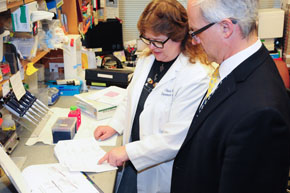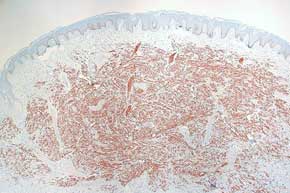Cutaneous Phenomics And Transcriptomics (CPAT)
The role of the Cutaneous Phenomics and Transcriptomics Core (CPAT) is to provide services and training necessary for the molecular characterization and histopathologic analysis of skin samples. Through both essential and innovative, state-of-the-art services CPAT Core’s mission it to provide investigators with key resources to determine the molecular and histologic features of skin and its diseases.
Expertise in skin tissue processing (FFPE and cryo) and microtomy are available, along with histochemical stains, immunoassays, RNAscope, LCM, and Barrier Testing services. For most services that are offered, protocols, consultation, training and equipment use is available. Additionally, the Core has access to an extensive archive of human skin disease and control samples, to provide investigators with FFPE clinical samples in the form of slides or ribbons/scrolls.
For convenience and efficiency, a comprehensive online form is used for submission of projects and requests, the details of which are automatically populated into a database, which is then used for tracking projects, core output, and billing.
The University is closed December 25th – January 2nd. Please note the following changes to our services:
-
Standard Tissue Processing and Histology:
-
Final day for processing/embedding will be Monday, December 15th. We will continue to work on fulfilling projects in the order in which they were received, and delivery may be in the new year. Samples collected after 12/15 may be stored fully submerged in 70% ethanol in a sealed container. You may continue to drop of samples and paperwork as normal, and they will be processed after the core reopens. If you need supplies, please see core staff by Monday, December 22nd.
-
-
Cassette Writer Access:
-
The Cassette writer will be shut down on Tuesday, December 23rd at noon. If you need cassettes for collection during the winter break, please print them in advance.
-
-
Immunostaining:
-
Service will continue through Monday, December 22nd.
-
-
LCM, Microtome, and Cryostat:
-
Trained users may continue to access the equipment during the break; trainings and slide service will resume when we return after the winter break. Note your ID card must give you access to 10BRB to enter the floor when the university is closed.
-
Please note key changes effective August 2025
- Updated pricing
- Processing and Turn-around times
- Updated Cassette Printing service – New August 2026!
- Cassette Printing Overview
- Basic Instructions, CPAT Core Cassette Writer
- Please note that published core pricing reflects the use of the cassette writer. We will offer a grace period through August 31, 2025, after which time a a sample transfer will be applied to your order invoice.
*Effective during normal operations, and subject to change
 Pricing
Pricing Protocols
Protocols Tissues
Tissues Histochemical Stains
Histochemical Stains Immunostaining
Immunostaining RNAscope in situ hybridization
RNAscope in situ hybridization FAQ
FAQ Publications
Publications


